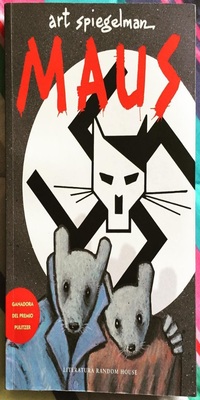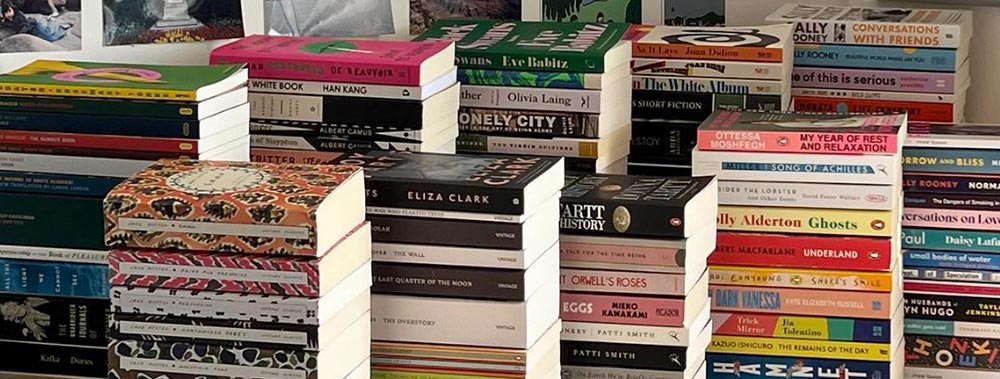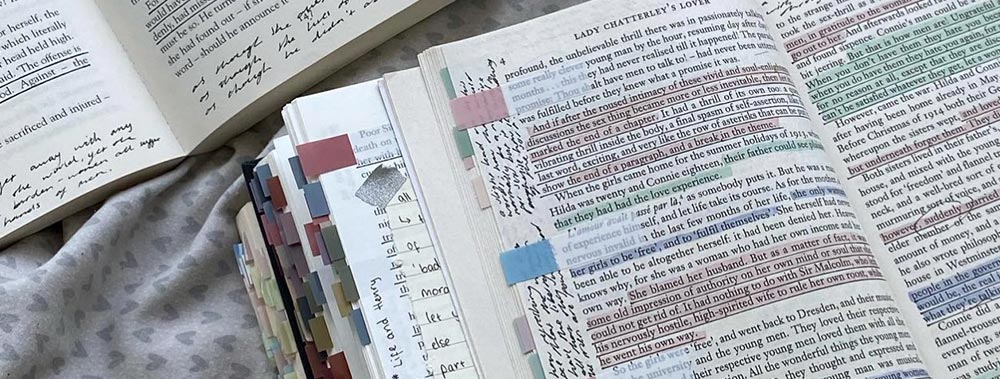Maus : Summary, Plot, Characters, Literary Analysis & More
“Maus” is a graphic novel by Art Spiegelman, first published in 1986.
This groundbreaking graphic novel stands as one of Art Spiegelman’s most celebrated achievements, garnering both critical acclaim and widespread popularity.
The novel portrays the poignant narrative of Vladek Spiegelman, a Holocaust survivor, and his experiences during World War II in Nazi-occupied Poland.
Through a unique blend of words and images, the novel delves into the relationship between Art and his father Vladek, as they navigate a complex web of personal history and family bonds against the backdrop of unimaginable hardship.
“Maus” confronts themes of resilience, intergenerational dynamics, and the enduring impact of trauma while shedding light on the harrowing experiences of Jewish prisoners during the Holocaust.

"Maus" confronts themes of resilience, intergenerational dynamics, and the enduring impact of trauma.
Table of Contents
Summary The Plot Characters Key Themes Genres Language used Literary devices Summing upThe Plot
Art Spiegelman’s Maus narrates the haunting journey of Vladek Spiegelman, Art’s father, through the traumatic landscape of World War II.
Art’s visits to Vladek serve as a framing device for the narrative, as the elderly Vladek recounts his tumultuous past, including his family life and experiences in Nazi-occupied Poland.
The story explores Vladek’s relationship with his mother, whose tragic suicide deeply affects him.
This graphic novel weaves together personal memoir and historical reimagining, depicting the harrowing realities of the Holocaust while delving into the intricate dynamics between father and son, memory and truth, as they come to terms with the enduring scars of the past.
Characters
Within this book, the characters Vladek and Art come to life, each carrying the weight of their shared history and complex intergenerational relationship amid the shadows of the Holocaust.
Vladek Spiegelman
Vladek is a central figure. He is Art Spiegelman’s father and a Holocaust survivor.
Through his detailed recollections, Vladek’s character emerges as resilient and resourceful, having endured the horrors of concentration camps and Nazi-occupied Poland during World War II.
His complex personality is shaped by his experiences, including the loss of his mother to suicide and his struggles to protect his family.
Art Spiegelman
Art is both the author and a character within “Maus.”
As the son of Vladek, he seeks to understand his father’s past by conducting interviews and recreating the historical events through his graphic novel.
Art’s complex relationship with his father, the weight of his inherited trauma, and his struggles to bridge generational gaps make him a multifaceted character in the narrative.
Anja Spiegelman
Anja, Vladek’s wife, and Art’s mother, plays a significant role in the narrative through her poignant presence and the impact of her tragic suicide.
Her haunting memory lingers as a driving force behind Vladek’s recollections and Art’s quest for understanding.
Other figures from Vladek’s past
Throughout “Maus,” a cast of characters from Vladek’s past—including friends, family members, and survivors—emerge, contributing diverse perspectives to the narrative.
Their stories unveil the complex network of relationships and struggles that shaped Vladek’s experiences during the Holocaust.
Key Themes
Themes are intricately woven into the narrative, exploring profound aspects of human experience against the backdrop of the Holocaust.
From intergenerational trauma shaping relationships to the resilience displayed in the face of adversity, these themes resonate powerfully, leaving an indelible mark on both characters and readers alike.
The Theme of Intergenerational Trauma
“Maus” delves into the theme of intergenerational trauma as Vladek’s experiences during the Holocaust profoundly impact both him and his son, Art.
The weight of the past influences their relationship, as Art grapples with his father’s history, symbolized by Vladek’s preserved artifacts like photographs and diaries.
The theme of Survival and Resilience
Survival and resilience are central themes in the narrative, exemplified by Vladek’s resourcefulness in the face of extreme adversity.
His accounts of surviving concentration camps and evading danger showcase the human capacity to endure, even in the darkest of times.
Genres in Maus
This book defies conventional literary categorization through its unique fusion of genres.
Seamlessly blending the graphic novel form with memoir and historical fiction, the work crafts an innovative narrative tapestry that invites readers to traverse the poignant landscapes of personal memory and collective history.
Graphic Novel
“Maus” is a groundbreaking graphic novel that artfully combines visual storytelling with textual narrative.
The use of comic art enhances the emotional impact of the story, allowing readers to visually connect with the characters’ experiences.
Memoir and Historical Fiction
The blending of memoir and historical fiction genres in “Maus” creates a unique narrative texture.
Through Art’s interactions with Vladek and his reimagining of historical events, the novel blurs the lines between personal memory and collective history, inviting readers to engage with the past on multiple levels.
Language used in Maus
Art Spiegelman’s language in “Maus” is a masterful blend of concise prose and visual storytelling, evoking a raw emotional atmosphere. The dialogue reflects the complexity of relationships, especially in exchanges between Vladek and Anja.
The language draws readers into Vladek’s narrative, as his recollections paint a vivid picture of his experiences during World War II.
The mix of words and images not only provides historical context but also amplifies the emotions, allowing readers to intimately engage with the characters’ pain, resilience, and hope.
Literary devices in Maus
“Maus” employs a multitude of literary devices to enhance its narrative depth. Vladek and Anja’s memories serve as a bridge to their past, while Vladek’s father becomes a historical touchstone.
The story’s beginning marks the inception of a multi-generational tale, with intertwining threads that traverse time.
These literary devices enrich the story’s texture, interconnecting past and present, weaving a narrative tapestry that captures the intricacies of human relationships and the enduring impact of history.
Similes
When Art visits his father, their interactions unfold like fragile origami, delicately revealing layers of history and emotion.
Vladek’s narrative unfurls like a tapestry, each thread a memory woven with the complexities of a Polish Jew’s life. His tale begins as a seedling, rooted in a father’s life, blossoming into a journey of survival against immense odds, akin to a phoenix rising from the ashes.
As Vladek loses loved ones, his heartache is likened to a puzzle with missing pieces, reflecting the gaps left by tragedy.
Metaphors
In the novel metaphors deepen the narrative’s significance.
Art’s visits to Vladek mirror time capsules, transporting him into his father’s world to uncover secrets, like the heart-wrenching story of his mother’s suicide, which hangs like a shadow over Vladek’s life.
Vladek’s life journey unfolds as a book, with chapters revealing moments of discovery and resilience, as if every page holds a piece of his identity. The Holocaust becomes a storm that devastates Vladek’s existence, leaving him emotionally destroyed, while his survival is portrayed as a triumphant battle.
As Vladek tells Artie his tale, their connection forms an unbreakable bond, a bridge between generations, as the story transcends time itself.
Analogies
Vladek’s discovery of hidden money functions as a metaphorical key, unlocking doors to forgotten chapters, much like unearthing buried treasures of the past.
His life’s trajectory, from Polish Jew beginnings to poignant ends, mirrors the narrative’s layered fabric. Analogous to a Polish soldier navigating war’s chaos, Vladek’s journey is marked by survival amidst turmoil.
His meeting with Anja is akin to a meeting of fates, intertwining lives against the backdrop of history’s canvas. As Art flies, his metamorphosis symbolizes generational change, while Vladek’s narrative bleeds history, vividly portraying lived experiences.
“Maus I,” a title echoing Vladek’s identity, encapsulates his journey’s beginnings. Just as Vladek’s life ends, his story concludes, like a chapter closing on the book of time.
Imagery
When Vladek discovers hidden remnants, akin to artifacts in a historical museum, unveils a gallery of memories, each one a window into his past.
The haunting aftermath of Vladek’s experiences in the Holocaust is portrayed with vivid imagery, mirroring a landscape scarred by the fires of destruction, leaving him emotionally shattered and a mere echo of his former self.
The story’s inception, akin to the tentative footsteps of Vladek’s journey, forms a mental photograph, encapsulating the essence of his origins. As Vladek’s odyssey unfolds, the vivid imagery weaves a narrative fabric, unfurling his beginnings and fostering a profound reader connection.
Symbolism
The gas chambers, emblematic of human atrocity, encapsulate the abyss of Holocaust horror. American soldiers, liberators like angels, epitomize freedom’s arrival.
Anja’s survival and her father’s tragic fate interlace destiny’s caprice within despair. The Russian army’s advance, a beacon of hope, resonates as liberation dawns. Vladek, survivor personified, embodies resilience in the face of adversity.
His narration of Art symbolizes memory as a bridge across generations. Nazi guards, shadowy oppressors, personify the cruelty of tyranny.
Polish smugglers personify courage in clandestine acts. The POW camp symbolizes captivity’s suffocating grip.
Anja’s suffering symbolizes silent anguish echoing through generations. The “hell planet” metaphor symbolizes the inferno of the Holocaust.
A young man’s fleeting presence echoes like a whisper in time. The comic book’s Pulitzer Prize symbolizes triumph through storytelling.
Personification
Vladek’s journey’s start embodies hope’s ember amidst darkness. American soldiers, heralds of freedom, personify liberation’s embrace.
Anja’s survival, fragile as a candle flame, entwines with her father’s tragedy, echoing destiny’s capricious hand.
The gas chambers, harbingers of terror, personify humanity’s darkest depths. The Russian army’s arrival, redemption’s herald, breathes life into liberation.
Vladek, the embodiment of survival, testifies to the indomitable human spirit.
His narrative, a torch passed to Art, personifies memory’s legacy. Nazi guards personify oppression’s malevolence.
Polish smugglers, embodiments of valor, illuminate clandestine courage. The POW camp personifies confinement’s torment.
Anja’s suffering, an unspoken wail, reverberates through the narrative’s core, and the “hell planet” metaphor personifies Holocaust horror.
Hyperbole
The narrative stretches reality to evoke the magnitude of historical events, such as the hyperbolic portrayal of “more Jews,” underscoring the Holocaust’s vast human toll.
The hyperbole underscores the tense relationship between Vladek and Anja, accentuating the complexities of love under duress.
Anja’s diaries become hyperbolic artifacts of memory, distilling the past’s enormity into intimate prose.
The Polish army’s heroic actions are heightened, amplifying their courage. Vladek’s dead brother looms as a hyperbolic shadow, a specter of loss.
Different camps become hyperbolic chapters of torment, capturing the spectrum of suffering. Amid the hyperbole, “Maus” emerges as a towering monument to the weight of Holocaust experiences.
Irony
The parents’ experiences, once vividly recounted, are juxtaposed with Art’s struggles to comprehend their magnitude.
The introduction of Mala, Vladek’s second wife, creates a poignant irony as she cares for him in his later years. The elusive Swiss border symbolizes the cruel irony of a fleeting chance at salvation amidst devastation.
The chilling guards’ march becomes an ironic cadence of oppression. The mere name of Auschwitz-Birkenau resonates with grim irony, encapsulating unimaginable horrors.
A wealthy manufacturer surviving the Holocaust is marked by the cruel irony of fate’s capriciousness.
Juxtaposition
The journey Vladek starts after the Holocaust stands in stark juxtaposition to his earlier life, highlighting the profound impact of the war.
When we see how Anja survive, Anja’s father has a change of fate that shows a poignant juxtaposition, emphasizing the capricious nature of destiny.
The liberation brought by the Russian army is set against the shadows of wartime oppression, creating a powerful juxtaposition of hope and despair.
Vladek’s narrative, as he tells Art, juxtaposes memories of endurance with the weight of history. The image of Anja suffering stands in a jarring juxtaposition to the youthful exuberance of the young man.
The world of the comic book, a realm of imagination, contrasts with the grim reality of Holocaust experiences. The act of Anja sending her diaries to Art creates an intimate juxtaposition, bridging past and present through words.
Paradox
When Vladek destroyed all of Anja’s diaries we see it as a paradox within his desire to preserve their history. As Vladek begins recounting his experiences, he unwittingly initiates a paradox, revisiting both trauma and resilience.
His father’s story holds the paradox of intertwining despair and strength, reflecting the human spirit’s duality.
When Vladek meets his son, Art, a paradox emerges in their generational connection, where survivor and descendant share the weight of history.
These paradoxical statements and situations mirror the complexities of the human experience, encapsulating pain and resilience, fragility and strength.
Allegory
The ordeal of surviving Gross-Rosen allegorically reflects humanity’s resilience in the face of adversity. A woman named Mala is caught between generations and becomes an allegory for the complexities of post-war identity.
Vladek and Anja sending their son, Art, into the world allegorizes the intergenerational transmission of history’s weight. Anja’s silent anguish while suffering personifies the broader pain endured during the Holocaust.
Vladek’s end forms an allegory of a survivor’s legacy, connecting past and present. The act of giving Vladek money symbolizes reparation, alluding to the attempts to mend history’s wounds.
Finally, the story begins in the 1970s and allegorically echoes the ongoing impact of history on the present.
Ekphrasis
As Vladek ends up in Dachau, the photograph of his tragic brother, Richieu, becomes a powerful ekphrasis.
The visual description captures the heartache of loss, freezing the memory within its frame.
Furthermore, when Vladek and Anja send their son to safety encapsulates an ekphrastic moment, wherein the emotional weight of their decision is etched into the visual narrative, adding depth to their story.
These ekphrastic elements paint emotional landscapes within the larger tapestry of the Holocaust narrative.
Puns
The reference to the mother’s suicide is a poignant pun, carrying both the personal tragedy and the broader historical weight of loss.
The phrase Vladek’s father resonates with a playful dual significance, referencing both lineage and authority. The singing of Jewish prisoners becomes a pun, symbolizing both captivity and the power of resistance through song.
The mention of the father’s life holds a double meaning, encompassing both personal experiences and the historical era.
Lastly, Vladek’s ends hold a profound dual meaning, signifying the conclusion of his tale and the end of his life.
The Use of Dialogue
Dialogue in “Maus” serves as a dynamic vehicle for character exploration and theme development. Conversations between characters like Vladek and Anja illuminate their complex relationship and the shared impact of history.
The tense relationship reverberates through dialogues, capturing emotional tension. Dialogues between Jews and nazis mirror the broader conflict, intertwining personal stories with history.
The interactions in Auschwitz and different camps reveal the spectrum of human responses to adversity.
Word Play
“Wordplay” in “Maus” amplifies meaning through linguistic manipulation.
Puns and double entendres add depth to characters like Vladek and Anja, enriching their interactions. Vladek’s destruction carries double meanings, signifying both physical loss and emotional devastation.
The phrase Anja suffers resonates with the weight of her emotional turmoil, employing wordplay to encapsulate her pain. Wordplay is a masterful tool, crafting meaning that resonates on multiple levels.
Parallelism
Parallelism in “Maus” creates structural harmony and thematic resonance.
The parallel accounts of Vladek and Anja in the Holocaust create a multifaceted narrative. Different camps mirror the varied facets of suffering.
The parallel stories of Jews and nazis underscore the shared humanity underlying historical roles. The unfolding of events in Auschwitz holds parallelism, tracing the trajectory of survival and suffering.
These parallel elements weave together a multi-layered narrative, reflecting the intricacies of history and humanity.
Rhetorical Devices
“Maus” employs rhetorical devices with persuasive impact, engaging readers emotionally and thematically.
The use of rhetorical questions, such as probing why the Holocaust occurred, stirs contemplation and invokes empathy.
Parallelism, seen in the interwoven narratives of Vladek and Anja, establishes a rhythmic cadence that drives home the shared human experience.
These devices serve as emotional conduits, guiding readers to introspection and fostering a profound connection to the characters’ struggles.
In doing so, “Maus” wields rhetorical devices to enrich its narrative impact and underscore the significance of history’s lessons.
Maus : FAQs
The “Maus” FAQ is a concise guide designed to answer common questions about Art Spiegelman’s groundbreaking graphic novel. Explore its themes, characters, and historical significance in this informative resource.
What is the main point of Art Spiegelman’s Maus?
Art Spiegelman’s “Maus” intricately weaves personal narratives with historical events, portraying the Holocaust’s profound impact on individuals and families. Through the stories of Vladek and Anja, it explores the lasting trauma and resilience born from tragedy.
What does Maus tell us about the Holocaust?
“Maus” delves into the Holocaust’s horrors, revealing the systemic dehumanization of Jewish people by Nazi forces. It underscores the inhumanity of concentration camps and the indomitable spirit of survivors, offering a poignant testament to history.
What happened to Vladek’s father during World War II?
During World War II, Vladek’s father faced the devastating reality of Nazi occupation in Poland. He endured the harrowing experiences that echoed the widespread suffering of countless Jewish families caught in the Holocaust’s grip.
What mental illness is in Maus?
“Maus” portrays Anja’s severe post-partum depression, a poignant reflection of the toll that unimaginable trauma can exact on mental well-being. This depiction highlights the emotional scars that linger long after the Holocaust’s end.
Summing up: Maus : Summary, Plot & More
As you now know from this “Maus” summary, the work transcends the boundaries of traditional storytelling, immersing readers in a haunting tapestry that interlaces personal history with global tragedy.
Through its innovative narrative structure and poignant illustrations, Art Spiegelman masterfully captures the raw emotions of survival, loss, and resilience.
The gripping accounts of Vladek and Anja resound as testaments to the indomitable human spirit. The vivid portrayal of Holocaust horrors, alongside moments of tenderness and connection, creates an immersive experience that resonates deeply.
By seamlessly weaving historical events with personal anecdotes, “Maus” forges a lasting bond between the readers and the characters, urging reflection on the profound implications of history.
This graphic novel stands as an enduring testament to the power of storytelling to illuminate the darkest corners of human history, ensuring that the lessons of the past remain etched in our collective memory.
Other Notable Works by Art Spiegelman
If you are interested in “Maus”, you may be interested in other works by Art Spiegelman including:
- “In the Shadow of No Towers“: An exploration of Spiegelman’s personal reflections on the aftermath of the September 11 attacks, combining vivid illustrations and introspective narratives.
- “Breakdowns“: This collection delves into Spiegelman’s early works, revealing his artistic evolution through a range of visual storytelling techniques.
- “MetaMaus“: Offering a fascinating behind-the-scenes look at the creation of “Maus,” this book includes interviews, sketches, and insights into the creative process.
- “Co-Mix: A Retrospective of Comics, Graphics, and Scraps“: This retrospective showcases Spiegelman’s diverse body of work, providing a comprehensive overview of his contributions to the world of comics and graphics.
- “Jack Cole and Plastic Man: Forms Stretched to Their Limits“: Spiegelman’s introduction to this collection sheds light on the life and artistry of Jack Cole, a legendary comic book creator.
Each of these works offers a unique perspective on Art Spiegelman’s artistic prowess and thought-provoking storytelling style, inviting readers to explore different facets of his creative journey.







